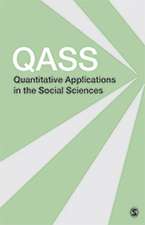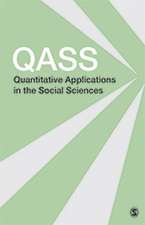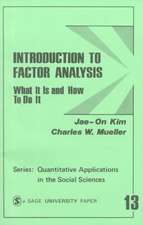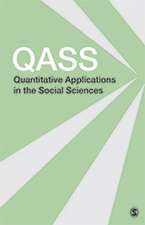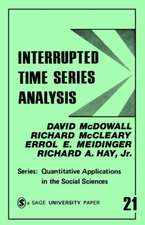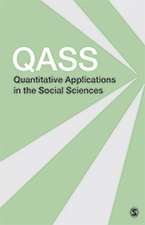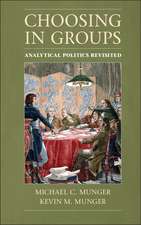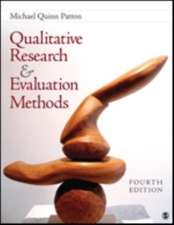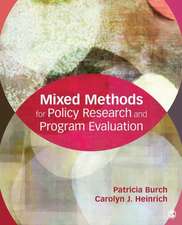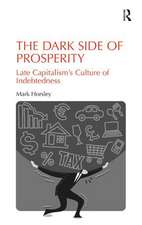Qualitative Secondary Analysis
Editat de Kahryn Hughes, Anna Tarranten Limba Engleză Hardback – 19 dec 2019
Exploring crucial components of research and analysis—such as where to find resources, how to search within a resource, and working with both paper archives and non-textual data—each chapter offers insightful case studies, links to further reading and applied helpful hints and tips to help effectively apply these innovations to further the reader’s own research.
A must read for Social Science students, early career researchers and researchers new to the field of QSA, this text will help readers through every aspect of a research process using QSA, from application to implications.
| Toate formatele și edițiile | Preț | Express |
|---|---|---|
| Paperback (1) | 333.85 lei 3-5 săpt. | +25.19 lei 7-13 zile |
| SAGE Publications – 19 dec 2019 | 333.85 lei 3-5 săpt. | +25.19 lei 7-13 zile |
| Hardback (1) | 852.92 lei 6-8 săpt. | |
| SAGE Publications – 19 dec 2019 | 852.92 lei 6-8 săpt. |
Preț: 852.92 lei
Preț vechi: 1107.69 lei
-23% Nou
Puncte Express: 1279
Preț estimativ în valută:
163.20€ • 170.40$ • 135.07£
163.20€ • 170.40$ • 135.07£
Carte tipărită la comandă
Livrare economică 05-19 aprilie
Preluare comenzi: 021 569.72.76
Specificații
ISBN-13: 9781526445247
ISBN-10: 1526445247
Pagini: 240
Dimensiuni: 170 x 242 mm
Greutate: 0.54 kg
Ediția:1
Editura: SAGE Publications
Colecția Sage Publications Ltd
Locul publicării:London, United Kingdom
ISBN-10: 1526445247
Pagini: 240
Dimensiuni: 170 x 242 mm
Greutate: 0.54 kg
Ediția:1
Editura: SAGE Publications
Colecția Sage Publications Ltd
Locul publicării:London, United Kingdom
Recenzii
'Practical, sensible and timely guide, inspiring teachers, researchers and students to work creatively with the wealth of archived qualitative data now freely available to us'.
Rachel Thomson, Professor of Childhood and Youth Studies, University of Sussex
This book confirms the standing of QSA securely within the mainstream of social science methods. It provides detailed chapters based on recent research using QSA, such as longitudinal QSA , nuanced comparative analysis, and blending existing with newly generated qualitative data. Fundamental ethical challenges that arise when repurposing data (e.g., the absence of explicit consent for reuse) are reviewed, and possible ways forward proposed. Instructors in need of a clear, accessible introduction to QSA for use in a methodology course will be well satisfied.
Dr Libby Bishop is the Coordinator for International Data Infrastructures in the Data Archive at GESIS-Leibniz Institute for Social Sciences.
Rachel Thomson, Professor of Childhood and Youth Studies, University of Sussex
This book confirms the standing of QSA securely within the mainstream of social science methods. It provides detailed chapters based on recent research using QSA, such as longitudinal QSA , nuanced comparative analysis, and blending existing with newly generated qualitative data. Fundamental ethical challenges that arise when repurposing data (e.g., the absence of explicit consent for reuse) are reviewed, and possible ways forward proposed. Instructors in need of a clear, accessible introduction to QSA for use in a methodology course will be well satisfied.
Dr Libby Bishop is the Coordinator for International Data Infrastructures in the Data Archive at GESIS-Leibniz Institute for Social Sciences.
Cuprins
PART I: CHANGING DATA LANDSCAPES AND QUALITATIVE SECONDARY ANALYSIS
Chapter 1: An Introduction to Qualitative Secondary Analysis – Kahryn Hughes and Anna Tarrant
Chapter 2: Qualitative Secondary Analysis: Working Across Datasets – Sarah Irwin
Chapter 3: The Ethics of Qualitative Secondary Analysis – Kahryn Hughes and Anna Tarrant
PART II BUILDING QUALITATIVE SECONDARY ANALYSIS INTO RESEARCH AND TEACHING
Chapter 4: Documents of Lives and Times: Revisiting Qualitative Data through Time – Bren Neale
Chapter 5: Search Strategies: Analytic Searching Across Multiple Datasets and Within Combined Sources – Rosalind Edwards, Susie Weller, Lynn Jamieson and Emma Davidson
Chapter 6: Collective Qualitative Secondary Analysis and Data Sharing: Strategies, Insights and Challenges – Anna Tarrant and Kahryn Hughes
Chapter 7: Qualitative Secondary Analysis in Teaching – Maureen Haaker
PART III METHODS OF QUALITATIVE SECONDARY ANALYSIS WITH NON-INTERVIEW DATA
Chapter 8: Looking Back, Looking Forward: Working with Archived Oral History Interviews – Joanna Bornat
Chapter 9: Doing Qualitative Secondary Analysis: Revisiting Young People’s Imagined Futures in Ray Pahl’s Sheppey Studies – Dawn Lyon and Graham Crow
Chapter 10: Imagination and the Analytical Potential of Working with Non-Interview or Unusual Data – John Goodwin and Henrietta O’Connor
Chapter 11: Using Quantitative Data in Qualitative Secondary Analysis – Jane Gray and Ruth Geraghty
Chapter 1: An Introduction to Qualitative Secondary Analysis – Kahryn Hughes and Anna Tarrant
Chapter 2: Qualitative Secondary Analysis: Working Across Datasets – Sarah Irwin
Chapter 3: The Ethics of Qualitative Secondary Analysis – Kahryn Hughes and Anna Tarrant
PART II BUILDING QUALITATIVE SECONDARY ANALYSIS INTO RESEARCH AND TEACHING
Chapter 4: Documents of Lives and Times: Revisiting Qualitative Data through Time – Bren Neale
Chapter 5: Search Strategies: Analytic Searching Across Multiple Datasets and Within Combined Sources – Rosalind Edwards, Susie Weller, Lynn Jamieson and Emma Davidson
Chapter 6: Collective Qualitative Secondary Analysis and Data Sharing: Strategies, Insights and Challenges – Anna Tarrant and Kahryn Hughes
Chapter 7: Qualitative Secondary Analysis in Teaching – Maureen Haaker
PART III METHODS OF QUALITATIVE SECONDARY ANALYSIS WITH NON-INTERVIEW DATA
Chapter 8: Looking Back, Looking Forward: Working with Archived Oral History Interviews – Joanna Bornat
Chapter 9: Doing Qualitative Secondary Analysis: Revisiting Young People’s Imagined Futures in Ray Pahl’s Sheppey Studies – Dawn Lyon and Graham Crow
Chapter 10: Imagination and the Analytical Potential of Working with Non-Interview or Unusual Data – John Goodwin and Henrietta O’Connor
Chapter 11: Using Quantitative Data in Qualitative Secondary Analysis – Jane Gray and Ruth Geraghty
Descriere
A comprehensive guide to carrying out Qualitative Secondary Analysis (QSA) that brings together expert advice and professional insight from leading researchers who have developed innovative theories and methods of QSA.

